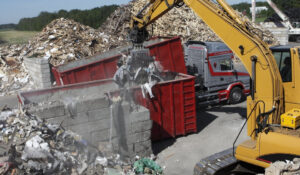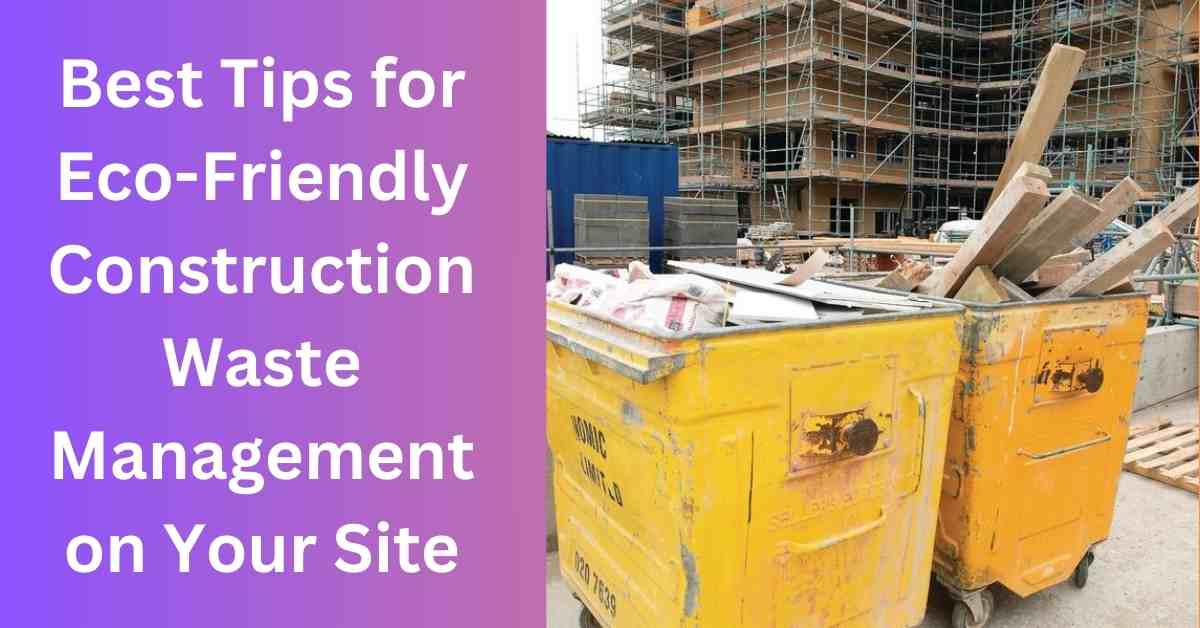Construction projects, whether large or small, often generate significant amounts of waste. This waste, if not properly managed, can harm the environment, increase costs, and slow down project timelines. However, with eco-friendly practices, you can handle construction waste efficiently while contributing to a healthier planet.
In this blog, we will discuss practical and easy-to-follow tips for construction waste management that can help you create a sustainable and cost-effective construction site.
NOTE : Are you looking for practical solutions to improve your construction waste management? Start implementing these tips today to create a more eco-friendly and efficient construction site. Partner with local recycling facilities, educate your team, and explore professional waste management services for seamless operations. Together, we can build a sustainable future, one construction project at a time.

Why Is Construction Waste Management Important?
Before diving into the tips, it’s essential to understand why construction waste management matters. Here are some key reasons:
- Environmental Protection: Unmanaged construction waste often ends up in landfills, causing pollution and harming ecosystems. Proper management reduces this impact.
- Cost Savings: Recycling and reusing materials can significantly lower waste disposal costs and the need for new resources.
- Compliance with Regulations: Many countries have strict laws regarding construction waste. Following best practices helps avoid fines and legal issues.
- Improved Reputation: Adopting eco-friendly practices enhances your company’s reputation and aligns with growing demands for sustainable development.
Common Types of Construction Waste
Understanding the types of waste generated on a construction site can help you manage it better. Common categories include:
- Concrete, Bricks, and Tiles: These materials are heavy and take up significant space in landfills.
- Wood: Often left over from framing or scaffolding.
- Metal: Includes steel, aluminum, and copper from wiring, plumbing, or structural elements.
- Plastics: Packaging materials, pipes, and insulation often contain plastics.
- Hazardous Waste: Paints, adhesives, and chemicals fall into this category and require special handling.
Best Tips for Eco-Friendly Construction Waste Management
1. Plan Ahead for Waste Management
Start with a waste management plan before construction begins. Assess the types of waste the project will generate and outline strategies for disposal, recycling, and reuse.
What to Include in Your Plan:
- Estimated quantities of each type of waste.
- Locations for sorting and storing waste on-site.
- A list of local recycling facilities and waste disposal services.
By planning ahead, you can reduce inefficiencies and ensure smooth waste handling throughout the project.
2. Reduce Waste at the Source
One of the easiest ways to manage waste is by reducing the amount generated in the first place.
Tips to Reduce Waste:
- Accurate Measurements: Avoid over-ordering materials by calculating precise quantities.
- Prefabricated Materials: Use prefabricated components to minimize cutting and excess materials on-site.
- Digital Blueprints: Switch to digital plans to eliminate paper waste.
Reducing waste at the source not only lowers costs but also simplifies the entire process of construction waste management.
3. Sort and Separate Waste On-Site
Sorting waste on-site makes recycling and disposal much easier. Designate specific areas or bins for different types of waste such as wood, metal, concrete, and plastics.
Benefits of Sorting:
- Easier to identify recyclable materials.
- Reduces contamination of recyclable waste.
- Saves time during waste transportation.
Implementing this simple step ensures that reusable and recyclable materials are not mixed with general waste.
4. Recycle Materials Whenever Possible
Recycling is a cornerstone of eco-friendly construction waste management. Many materials commonly used in construction can be recycled, reducing the need for virgin resources.
Recyclable Construction Materials:
- Concrete and Asphalt: Crushed and reused as aggregate for new roads or foundations.
- Metals: Melted and reformed into new products.
- Wood: Repurposed for furniture or construction elements.
- Plastics: Processed into new building materials or insulation.
Partner with local recycling facilities to ensure your waste is handled responsibly.
5. Embrace Reuse to Save Resources
Reusing materials is another excellent way to manage construction waste sustainably. Not only does this save money, but it also reduces the demand for new materials.
Examples of Reusable Materials:
- Bricks and Stones: Used in landscaping or as decorative elements.
- Wood: Repurposed for furniture or scaffolding.
- Doors and Windows: Salvaged and installed in other projects.
Encourage your team to identify reusable materials during demolition or cleanup phases.
6. Work with Eco-Friendly Suppliers
Choose suppliers who prioritize sustainability. These companies often provide materials with minimal packaging or options made from recycled content.
What to Look for in Suppliers:
- Certifications for sustainable practices.
- Use of recyclable or biodegradable packaging.
- Materials that have a lower environmental impact.
By working with eco-friendly suppliers, you contribute to a greener supply chain.
7. Educate Your Team About Waste Management
Your workers play a significant role in implementing construction waste management practices. Conduct training sessions to educate them on sorting, recycling, and reducing waste.
Key Training Topics:
- Identifying recyclable and reusable materials.
- Proper handling of hazardous waste.
- Importance of waste management for the environment and project success.
An informed team is more likely to follow waste management protocols effectively.
8. Hire Professional Waste Management Services
If managing construction waste seems overwhelming, consider hiring professional services. These companies specialize in handling and disposing of construction waste in compliance with regulations.
Advantages of Hiring Professionals:
- Saves time and effort.
- Ensures compliance with local laws.
- Guarantees proper recycling and disposal of hazardous materials.
Professional services are especially helpful for large-scale projects where waste management can be complex.
9. Monitor and Evaluate Your Waste Management Practices
Finally, regularly assess your waste management efforts to identify areas for improvement. Keep track of the amount of waste generated, recycled, and reused.
How to Monitor Effectively:
- Maintain records of waste quantities and disposal methods.
- Conduct regular audits to check compliance with the waste management plan.
- Adjust strategies based on project requirements.
Monitoring ensures that your efforts remain effective and sustainable throughout the project.
Conclusion
Eco-friendly construction waste management is not just a responsibility but also a smart business practice. By reducing, reusing, and recycling waste, you can save costs, improve efficiency, and contribute to a healthier environment. Whether it’s through careful planning, sorting materials on-site, or partnering with professionals, adopting these practices ensures your construction site runs smoothly and sustainably.
For more insightful articles related to this topic, feel free to visit netblogz
